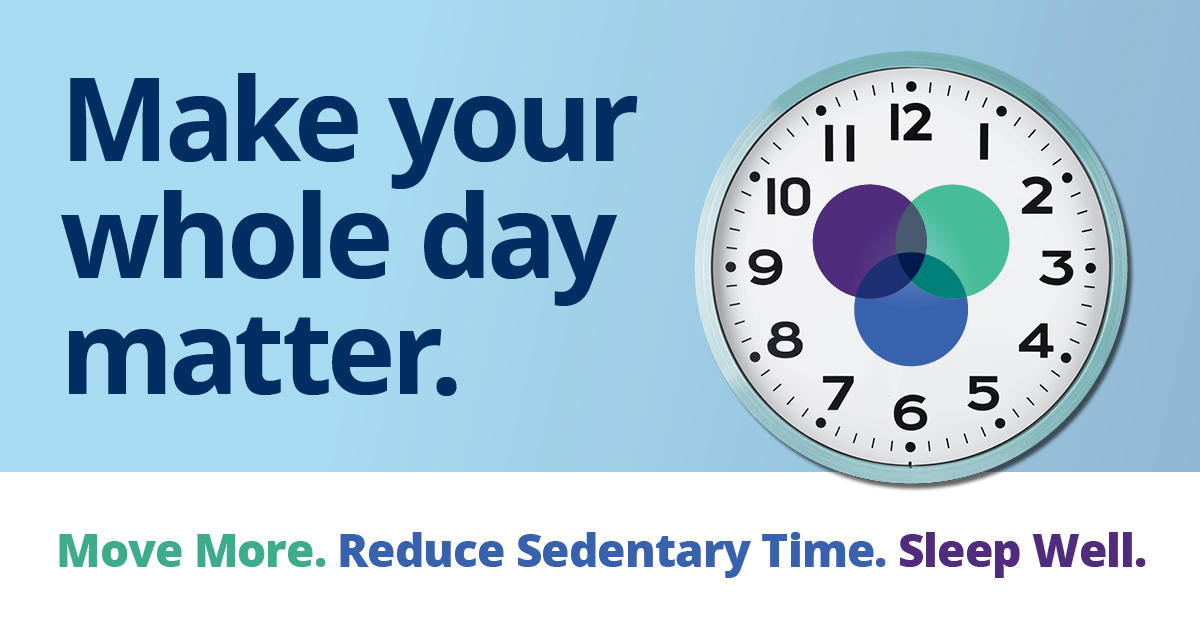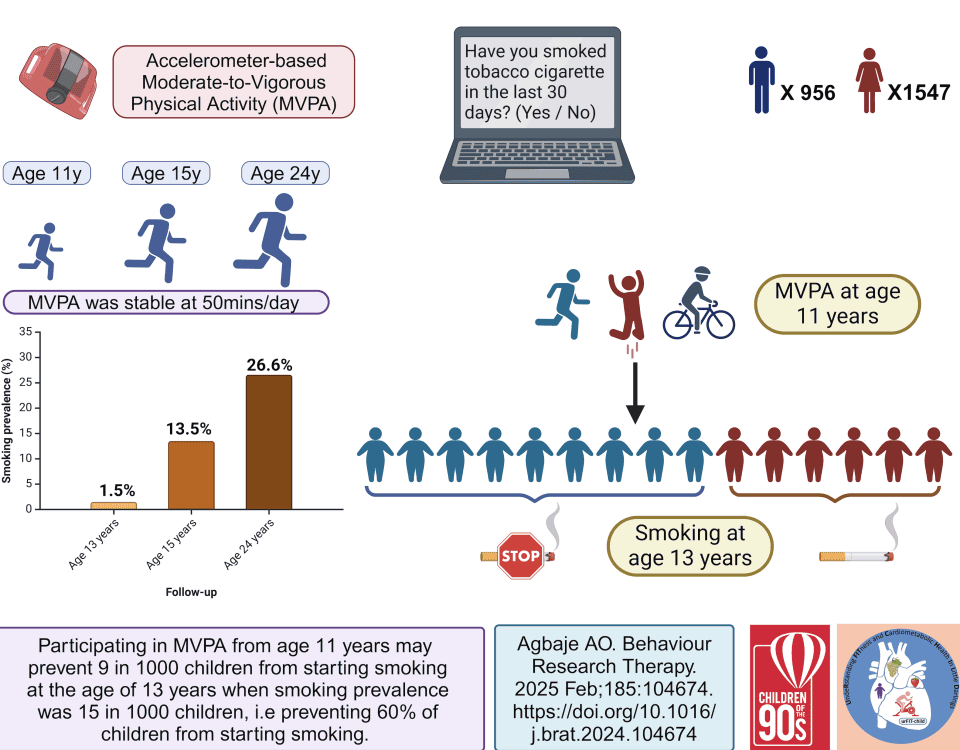
Sedentary Time Accumulated in Bouts is Positively Associated with Disease Severity in Fibromyalgia: The Al-Ándalus Project
October 8, 2020
Popliteal flow-mediated dilatory responses to an acute bout of prolonged sitting between earlier and later phases of natural menstrual and oral contraceptive pill cycles
October 22, 2020
This morning Canada released the world’s first 24-hour Movement Guidelines for Adults. This completes a cycle that began when Canada released the first 24-hour Movement Guidelines for school-aged children and youth in 2016, and for the early years in 2017. In line with 24-hour Movement Guidelines for other age groups, these new Guidelines provide specific recommendations related to physical activity, sedentary behaviour and sleep.
In addition to being the first 24-hour Movement Guidelines for adults, these are also the first national Guidelines to provide specific recommendations for daily sedentary behaviour in this age group.
The full Guidelines, as well as all supporting documents, can be found at csepguidelines.ca.
What are the Guidelines?
Adults 18 to 64 years:
For health benefits, adults aged 18-64 years should be physically active each day, minimize sedentary behaviour, and achieve sufficient sleep.
A healthy 24 hours includes:
Performing a variety of types and intensities of physical activity, which includes
- Moderate to vigorous aerobic physical activities such that there is an accumulation of at least 150 minutes per week
- Muscle strengthening activities using major muscle groups at least twice a week
- Several hours of light physical activities, including standing
Limiting sedentary time to 8 hours or less, which includes
- No more than 3 hours of recreational screen time, and
- Breaking up long periods of sitting as often as possible
Getting 7 to 9 hours of good-quality sleep on a regular basis, with consistent bed and wake-up times
Replacing sedentary behaviour with additional physical activity and trading light physical activity for more moderate to vigorous physical activity, while preserving sufficient sleep, can provide greater health benefits.
Progressing towards any of these targets will result in some health benefits.
Adults 65 years and older:
For health benefits, adults aged 65 years or older should be physically active each day, minimize sedentary behaviour, and achieve sufficient sleep.
A healthy 24 hours includes:
Performing a variety of types and intensities of physical activity, which includes
- Moderate to vigorous aerobic physical activities such that there is an accumulation of at least 150 minutes per week
- Muscle strengthening activities using major muscle groups at least twice a week
- Physical activities that challenge balance
- Several hours of light physical activities, including standing
Limiting sedentary time to 8 hours or less, which includes
- No more than 3 hours of recreational screen time, and
- Breaking up long periods of sitting as often as possible
Getting 7 to 8 hours of good-quality sleep on a regular basis, with consistent bed and wake-up times
Replacing sedentary behaviour with additional physical activity and trading light physical activity for more moderate to vigorous physical activity, while preserving sufficient sleep, can provide greater health benefits.
Progressing towards any of these targets will result in some health benefits.
How were the Guidelines developed?
The recommendations for sedentary behaviour were developed by incorporating evidence from an overview of systematic reviews by Saunders et al., the US Physical Activity Guidelines Advisory Committee (PAGAC) Scientific Report, and other published meta-analyses. In their overview of systematic reviews, Saunders et al. concluded that:
High levels of sedentary behaviour are unfavourably associated with:
- Cognitive function
- Depression
- Function and disability
- Physical activity levels
- Physical health related quality of life
Total sedentary behaviour and TV viewing were most consistently associated with unfavourable health outcomes, while computer and Internet use may be favourably associated with cognitive function for adults over the age of 65.
Finally, they concluded that reducing or breaking up sedentary behaviour may benefit body composition and markers of cardiometabolic risk.
They also concluded that the quality of evidence was Low to Very Low for all outcomes.
The US PAGAC Scientific Report concluded that:
- “Strong evidence demonstrates a significant relationship between greater time spent in sedentary behavior and [1] higher all-cause mortality rates and [2] higher mortality rates from cardiovascular disease”; and that:
- “Strong evidence demonstrates the existence of a direct, curvilinear dose-response relationship between sedentary behavior and all-cause mortality, with an increasing slope at higher amounts of sedentary behavior.”
- “Strong evidence demonstrates the existence of a direct, positive dose-response relationship between sedentary behavior and mortality from cardiovascular disease”
Finally, meta-analyses on the dose-response between sedentary behaviour and mortality have reported that the risk of all-cause mortality increases more rapidly above thresholds of 7-9.5 hours/day of daily sedentary behaviour (Chau et al. 2013; Ku et al. 2018, 2019; Patterson et al. 2018; Ekelund et al. 2019), and above thresholds of 3-4 hours/day of daily TV viewing (Grøntved and Hu 2011; Patterson et al. 2018; Sun et al. 2015).
The complete process used to create these Guidelines, as well as the evidence supporting them, can be found in a special issue of the journal of Applied Physiology, Nutrition and Metabolism. Information specific to the sedentary behaviour recommendations can be found in an overview of systematic reviews by Saunders et al., as well as the paper detailing the Guidelines by Ross et al.
Support and Criticism
Prior to their release, draft Guidelines received stakeholder feedback, including 126 SBRN members. In a commentary published this morning in the Journal of Sport and Health Science, Tremblay et al. summarize this feedback:
Based on SBRN members’ responses to the stakeholder survey… there is strong, though not unanimous, support for the sedentary behavior recommendations in the new guidelines. 82.3% of participants indicated that they ‘somewhat agree’ or ‘strongly agree’ that the sedentary behavior recommendations are clearly stated and 80.2% reported they ‘somewhat agree’ or ‘strongly agree’ with how the sedentary behavior recommendation is stated. Conversely, a relatively small percentage of participants felt the recommendation was not clearly stated (10.7%) or disagreed with how the recommendation was stated (15.9%). Additional comments from SBRN stakeholders were primarily concerned with quantifying “prolonged sitting” (n = 17), defining “sedentary” and providing practical examples (n = 11), and defining “recreational screen time” (n = 2). Only a few members (n = 4) suggested the recommendations were unrealistic and/or intimidating.
Tremblay et al. also point out that these Guidelines are in line with recent recommendations that encourage “guideline developers to provide specific advice even if they underlying evidence is of low quality of insufficient”.
In contrast, in a responding commentary also in the Journal of Sport and Health Science, Stamatakis and Bauman are concerned with the level of evidence currently available, in particular noting that much of the current evidence is cross sectional in nature, which could allow for reverse causality (e.g. poor health leading to increased sedentary behaviour, rather than the other way around). They also cite concerns over the range of thresholds for increased risk of mortality seen in available dose-response studies, and the fact that available evidence for recreational screen time is based on studies of TV viewing, which is predisposed to confounding. They suggest that instead the focus should be on the development of compositional approaches, which could lead to more robust 24-hour Guidelines. Finally, they state that they “hope that users of these guidelines will approach them favourably but critically, and that future guidelines developers will re-appraise the evidence and not uncritically adopt such approaches for “fear of missing out””.
For more information on the Guidelines and their development process, visit csepguidelines.ca.
Travis Saunders is an Associate Professor in the Department of Applied Human Sciences at the University of Prince Edward Island. He is a founding member of SBRN, and the Sedentary Behaviour Content Expert on Canada’s 24-Hour Movement Guidelines for Adults.



